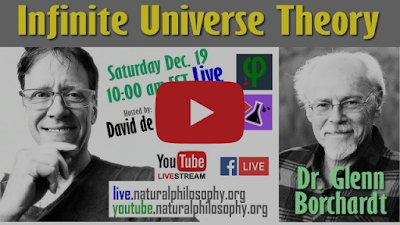PSI Blog 20201228 Rick Dutkiewicz's Take on Paradigm Patching: Religion and Big Bang Theory
Guest Blog by Rock and Roll Star
Rick Dutkiewicz
Glenn,
Just to belabor the obvious;
The constant ad-hoc patching of the Big Bang Theory is
reminiscent of the methods used over centuries by the churches. As their
explanations of the way things work become more and more untenable, they need
to come up with more lame-brained explanations for the pew-potatoes.
To explain away the creation story’s unscientific narrative:
“Each of the 6 days of God’s creation represented billions
of years. After all, we all know that God is beyond time. Yeah, that’s the
ticket”.
To explain away the acceptance of slavery:
“The Old Testament guidelines for slavery were not to
advocate or allow slavery, but to temper the suffering caused by universal
slavery at that time. After all, God couldn’t ask his chosen people to change
their cultural traditions like slavery and female subjugation. God is willing
to work with people where they are, not where they ought to be. He works within
messy human cultures to move them towards redemption. Yeah, that’s the ticket”.
To explain away the slaughtering of entire cities by the
chosen people (of a Loving God):
"God’s command for Israel to drive out the Canaanites
was not race-based, but behavior-based, as the Canaanites engaged in acts that
would be considered criminal in civilized societies. The Old Testament’s
mention of many Canaanite survivors shows that its “total-kill” language is
simply Ancient Near Eastern exaggeration or hyperbole. So, we were forced to
kill every living thing in the city, it’s the victims' fault. That’s the
ticket.”
You can find websites full of these apologetic patchwork
quilts. Never mind that if you can call one part of the Bible story “hyperbole”
or “exaggeration” to work around bad science or immorality, you’ve opened the
door to calling the entire Bible “hyperbole” and “exaggeration”.
It’s one thing that religious folks fall for this crap
without realizing the implications to their entire mythos, but how can
“objective” and “peer-reviewed” scientists engage in the same type of
apologetics as our religious friends?
The answer to that last question is discussed in this great new book:
“Religious Roots of Relativity” by Glenn Borchardt.
Thanks for your work.
Rick Doogie
Allegan, Michigan
[GB: Thanks so much Rick. That reminds me of an old saying I just found on the Web: "Religion is blasphemy of science."]










